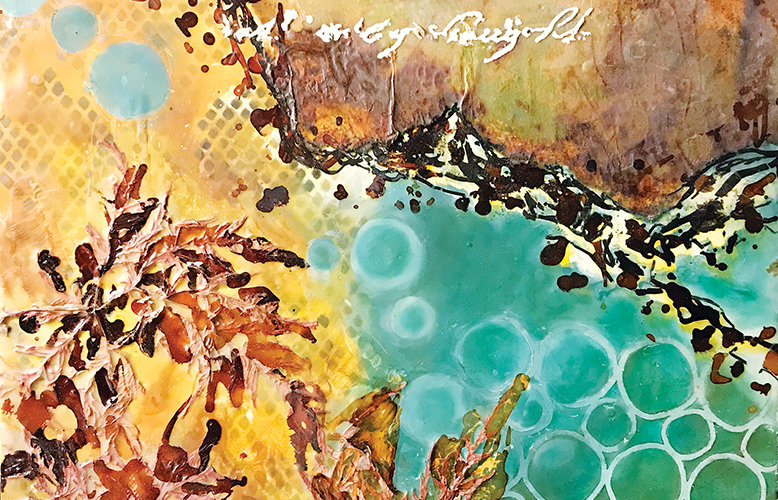(Artwork above: Encaustic Image by Suzi Bradley Sheward)
Suzi Bradley Sheward, an artist and former resident of the Bend area, is embracing new but very old art: Encaustics Encaustic, meaning to “burn in” was first used by the Greeks in the Fifth Century BCE. Encaustic paint is a mixture of beeswax and damar crystals melted together to form a paint and must be kept molten as its applied to a surface. Damar crystals come from the sap of a tree and is also made into varnish. The wax is fused to a surface by a torch or other heating method and each successive layer must be fused as well to become a part of the painting in progress. It’s extremely durable as wax is impervious to water so the painting won’t deteriorate, yellow or darken. The damar and wax together form a surface that requires no protection, the surface is hard and polishes into a high gloss.
“My formal schooling was in commercial art rather than fine. I’ve sometimes wished I could paint like the impressionists today but that really wasn’t what I really felt…in the end I’d find myself licking the point on a small brush focusing on detail yet again. Through the years I painted rodeo and automotive posters, paintings, two of which were featured on the cover of Arts and Entertainment.
For a few years I was fabricating western decor from leather and Pendleton fabric which I still do occasionally but was always looking for some other freer, more exciting venue for artistic expression” says Sheward.
“In Santa Fe, New Mexico, I walked into an encaustic gallery and instantly knew this unusual art form was for me. I was taken by its visual effect because the layers of wax are built up giving the painting different depths that, along with textural and color possibilities, aren’t possible with other art forms. Wax can be modeled, sculpted, combined with collage materials and still retain its beautiful and durable properties. After the Santa Fe experience I scoured the internet watching hours and hours of You Tube videos to see other examples and learn how other people were creating art with wax. The videos were the only way I could learn as there aren’t many workshops or artists close with whom to study. Working with hot wax does have its up and downs with a huge learning curve. I found that it’s not good to visualize a final effect because it’s never going to end up that way. Holding heat too close or too long in one area will cause the wax to blossom into something surprisingly different than planned. While torching wax isn’t precise it is also a little dangerous. I’ve accidently burned papers, pencils, rags and singed my hair on more than one occasion while not paying attention. A handy fire extinguisher is an absolute necessity in the studio.
At the present time I am in the process of sending a small body of work to an encaustic art exhibit and show in Santa Fe.

